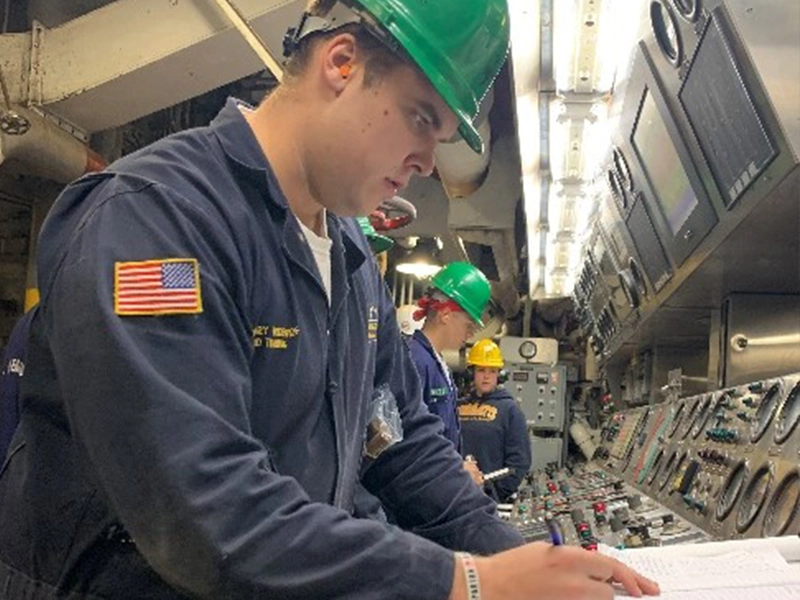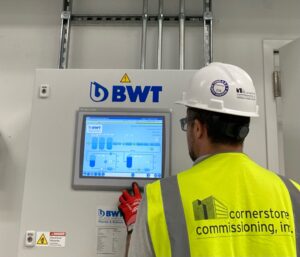Biosafety Level 3 (BSL-3) laboratories are among the most critical facilities in biomedical research and public health. These labs are designed to support work with infectious agents that can cause serious or potentially lethal disease through inhalation. To mitigate these risks, strict engineering controls, specialized equipment, and stringent procedures are required. Performance verification is central to maintaining the integrity of these environments.
Without regular verification, even minor system failures, such as a loss of pressure differentials or an improperly functioning autoclave, can put workers and surrounding communities at risk. That is why governing bodies mandate regular testing and validation for BSL-3 facilities.
But these verification activities often require labs to pause operations, creating downtime that disrupts ongoing experiments, causes financial loss, and delays critical projects. In environments where time-sensitive research supports vaccines, diagnostics, and life-saving therapies, such delays can have wide-ranging consequences.
The challenge, then, is balancing safety and compliance with operational continuity. With proper planning and the right expertise, labs can minimize downtime during verification, ensuring that science moves forward without compromising biosafety.
Understanding BSL-3 Performance Verification
Performance verification encompasses a wide set of activities that confirm all safety and facility systems in a BSL-3 lab are functioning as intended. Unlike basic facility checks, BSL-3 verification is comprehensive and includes redundant testing to account for worst-case scenarios.
Key elements of the process include:
- HVAC Testing and Balancing: Airflow is the foundation of any high-containment lab. For BSL-3 facilities, negative pressure must be maintained at all times to ensure contaminants remain inside the controlled zone. Testing includes smoke visualization studies to confirm directional airflow, pressure differential monitoring to verify gradients between rooms, and HEPA filter integrity testing using aerosolized challenge particles. Balancing supply and exhaust systems is critical; even minor imbalances can create positive pressure and risk containment breaches.
- Containment Integrity Assessments: Every physical barrier plays a role in biosafety. Performance verification requires a detailed inspection of door seals, interlocks, pass-through chambers, and wall penetrations for potential leaks. Technicians may use tracer gas testing or low volume smoke to identify leaks in the containment barrier. Verifying interlock systems ensures that doors never open simultaneously, maintaining secure compartmentalization within the lab.
- Sensor and Control Calibration: Sensors and alarms are the lab’s constant sentinels, monitoring airflow rates, temperature, humidity, and air changes per hour (ACH). Calibration confirms these devices provide accurate, reliable data under both normal and emergency conditions. Even a small drift in calibration can result in nuisance alarms that disrupt research or, more seriously, a failure to detect hazardous conditions.
- Autoclave and Decontamination Verification: Autoclaves, chemical showers, and fumigation systems must consistently neutralize biological hazards before waste exits the facility. Verification uses biological indicators (such as spore strips) and chemical integrators to validate sterilization cycles. These checks confirm that decontamination processes are reliable, repeatable, and meet biosafety level 3 requirements for pathogen inactivation.
- Envelope Integrity Testing: The physical envelope—walls, ceilings, floors, and structural joints—must remain airtight to maintain containment. Testing may include blower door assessments to measure leakage rates and infrared thermography to detect weaknesses in construction. Penetrations for piping, conduits, and ducts are inspected to ensure sealants are intact and flexible under operational stresses.
- Failure Scenario Simulations: No verification is complete without testing how the lab performs under stress. Simulated failures such as power outages, exhaust fan shutdowns, or BAS malfunctions validate redundancy systems and emergency protocols. For example, backup generators and redundant exhaust fans must activate seamlessly to maintain negative pressure. These simulations provide confidence that the facility can withstand real-world emergencies without compromising safety.
Standards such as ANSI Z9.14, the CDC/NIH Biosafety in Microbiological and Biomedical Laboratories (BMBL), and ISO 35001 provide frameworks for these activities. Most regulatory bodies require annual performance verification, but many institutions conduct interim checks to support continuous compliance.
For more detail, Cornerstone has highlighted work across multiple biosafety level 3 labs, demonstrating the importance of rigorous, repeatable processes.
The True Cost of Downtime in BSL-3 Labs
The impacts of downtime extend far beyond the hours or days a lab is closed. In BSL-3 facilities, interruptions create cascading consequences that affect finances, compliance, and safety.
Direct Costs
Experiments that are halted midstream often cannot be resumed, requiring researchers to start from scratch. This leads to wasted reagents, lost samples, and extended project timelines. For grant-funded institutions, missed milestones can jeopardize funding streams. In addition, the cost of reordering specialized materials or repeating animal studies can add hundreds of thousands of dollars to a single project’s budget.
Indirect Costs
Regulatory bodies take a close interest in how labs manage verification. Unplanned downtime can lead to findings of non-compliance, which may delay approvals for future work. In addition, reputational harm from repeated downtime incidents can make it more difficult to attract top researchers or secure new grants. These indirect impacts can also ripple outward to collaborations, as partner institutions may hesitate to engage with labs that demonstrate operational instability.
Safety Risks
Downtime also introduces unique safety risks. Shutting down systems such as HVAC can disturb carefully maintained pressure relationships, making containment more vulnerable. Restarting systems can create transient conditions where risks of exposure or release are heightened. Even brief lapses in containment integrity during shutdown or startup phases can put both staff and surrounding communities at risk, underscoring why safety is inseparable from operational continuity.
Strategies to Minimize Downtime
Reducing downtime during BSL-3 performance verification requires careful coordination, technical expertise, and proactive communication. Because biosafety level 3 requirements demand rigorous validation of containment and safety systems, even minor inefficiencies in scheduling or execution can cause major disruptions. By combining thoughtful planning with modern tools and experienced partners, labs can keep essential research moving forward while still maintaining the highest safety and compliance standards.
Pre-Verification Planning
Effective planning is the cornerstone of minimizing downtime. Aligning verification schedules with natural research slowdowns, such as evenings, weekends, or academic holiday break, limits disruptions to ongoing projects.
Developing detailed standard operating procedures (SOPs) and comprehensive checklists ensures each verification step is clearly defined, reducing the likelihood of errors or missed tasks. This proactive approach not only saves time during the verification itself but also helps facilities identify potential bottlenecks in advance, keeping research schedules intact.
Real-Time Solutions
New verification tools make it possible to test systems while they remain operational. For example, airflow visualization using tracer smoke can be conducted without shutting down supply and exhaust fans, allowing researchers to continue working in unaffected zones. Similarly, continuous pressure monitoring validates containment performance without requiring system interruptions.
In some facilities, advanced in-situ calibration devices allow sensors to be tested under real operating conditions. These innovations shorten the time needed for verification, helping labs maintain momentum in their research programs.
Audit-Ready Documentation
Documentation is often the hidden cause of extended downtime. Traditional paper logs or manual reporting can add days or even weeks to the verification process. By implementing digital logs, automated reporting systems, and centralized cloud-based repositories, labs can generate audit-ready records in real time.
This ensures that regulators, accreditation bodies, and internal safety officers have immediate access to accurate data. Streamlined documentation not only reduces post-verification delays but also enhances transparency and accountability across the organization.
Communication and Training
Miscommunication is a leading factor in downtime extension. Cross-training ensures that multiple staff members can step in if key personnel are unavailable, preventing delays caused by scheduling conflicts. Engaging stakeholders early—including commissioning agents, principal investigators, biosafety officers, and facility managers—creates a unified understanding of goals and expectations.
Clear communication protocols also prevent duplication of effort or overlooked steps, both of which can stall the verification process. When everyone knows their role and responsibilities, verification can proceed smoothly and efficiently.
Partnering with Experienced Commissioning Teams
The most effective way to minimize downtime is to work with commissioning professionals who specialize in high-containment environments. Experienced teams bring decades of lessons learned, allowing them to anticipate potential bottlenecks and implement proven strategies for streamlining verification.
Cornerstone Commissioning, supported by Technical Safety Services, has built a reputation for providing commissioning services tailored to the complex needs of BSL-3 facilities. Their hands-on, detail-oriented approach integrates performance verification seamlessly into daily operations, helping facilities remain compliant with biosafety level 3 requirements while protecting critical research timelines.
Ensuring Resiliency in BSL-3 Labs
Downtime in BSL-3 verification is not just an operational concern—it is a matter of safety, compliance, and scientific progress. By planning carefully, adopting real-time testing methods, maintaining audit-ready documentation, investing in staff training, and engaging experienced partners, labs can dramatically reduce downtime.
As research grows more urgent and pathogens become more complex, minimizing downtime will only become more critical. Forward-thinking facilities will treat downtime reduction not as an optional improvement but as a core part of their biosafety culture. Resiliency also means preparing for the unexpected—whether it is a sudden equipment failure, a regulatory audit, or an emerging infectious threat. By embedding downtime reduction strategies into everyday operations, BSL-3 facilities strengthen their ability to maintain safe, reliable, and continuous research environments.
Partnering with experts like Cornerstone Commissioning, which brings decades of hands-on experience with high-containment facilities, provides labs with proven methodologies and practical insights to anticipate challenges before they cause disruptions. Facilities that prioritize resiliency in verification with the support of commissioning specialists will be best positioned to advance science safely, efficiently, and without unnecessary interruptions.





